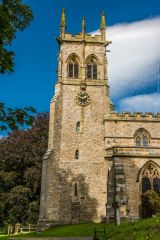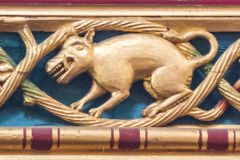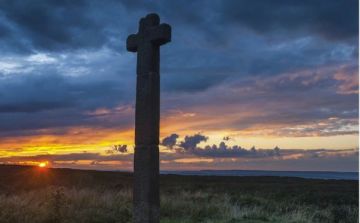
The attractive medieval church of St Andrew stands above the River Ure in the Yorkshire Dales beauty spot of Aysgarth. it has the largest churchyard in England, covering an area of over four acres. This beautiful medieval building is known for its stunning medieval chancel screen, brought here from Jervaulx Abbey when the abbey was suppressed by Henry VIII.
History
There has been a place of worship in this location since at least the 10th century. In 1968 the vicar's son was playing near the churchyard and discovered a 10th-century cross head embedded in a nearby stone wall. The cross may have been a preaching cross, with travelling priests meeting there to preach, or it may have stood outside a Saxon church. Sadly, the cross-head was stolen in 1996 and never rediscovered.

There was a church here in the 12th century when it was the mother church of a chapel of ease at Askrigg. The first recorded rector of Aysgarth was Peter de Thoresby, appointed in 1236. Thoresby's descendant became Archbishop of York in 1354.
The Norman church was rebuilt in 1536 but by the Victorian period it was in a poor state. It had to be completely restored in 1866, giving it a decidedly Gothic revival air. Despite the sweeping Victorian changes the church retains some remarkable historical features.
Historical Highlights
- Medieval wall painting depicting the Calling of St Andrew
- 1536 carved beam over the vestry door
- High altar and reredos of Caen stone
- Abbot's Stall from Jervaulx Abbey
- Medieval screen from Jervaulx Abbey
- Victorian stained glass windows

The Jervaulx Screen
By far the most impressive feature is the Jervaulx Screen, brought here when the abbey was closed by Henry VIII during the Reformation. It is possible that the parishioners bought the screen from Henry VIII's commissioners but it is perhaps more likely that it was spirited away by the monks of Jervaulx when they saw that the end of the monastery was quickly approaching. Tradition says that it took 20 men to carry the screen from Jervaulx to Aysgarth.
The Jervaulx Screen has similarities to a bench end finial at Ripon Cathedral, suggesting that they were carved by the same 'Ripon School of Carving' craftsmen. The ornately carved and painted screen has a magnificent frieze of gilded figures running along the top of the canopy. The figures include an elephant and castle, a fox, a dragon, an eagle, a boar, a lion, and an antelope, all interspersed with foliage. The quality of craftsmanship is staggering.
All the figures are symbolic and are meant to convey moral lessons. For example, two beats show biting their backs are a warning against back-biting, while an antelope entangled in branches is a warning to avoid strong drink.

One point about the Jervaulx Screen is easy to overlook; it is completely at odds with the values of the Cistercian order. Cistercian churches were supposed to be plain and unadorned, but there is nothing remotely plain about the screen and the beautifully-carved abbot's stall.
The Abbot's Stall (also known as the Vicar's Stall) bears the rebus (a heraldic punning symbol) of Abbot William de Heslington, who was appointed in 1472. The frieze atop the screen bears the initials WH, suggesting that both the screen and stall were built during Abbot William's tenure. The stall has a pair of beautifully-carved bench ends with poppy heads. One bench end has the initials HM with a crozier and mitre. This is thought to represent Marmaduke Huby, the Abbot of Fountains Abbey from 1495–1526.
Over the vestry door is a timber beam inscribed 'AS Abbas Ann. D'm. 1536', for Adam Sedbergh, the last Abbot of Jervaulx Abbey, who was executed for his role in the Pilgrimage of Grace. The inscription commemorates the rebuilding of St Andrew's Church in that year.

The high altar and reredos were carved in 1887 as a memorial to Henry Robinson, a patron of the 1886 restoration. The sculpture in Caen stone is by RL Boulton of Cheltenham. Boulton was a Catholic and created a stone altar in Catholic style, but added a wooden top to make it technically a 'table' to conform with Anglican rules.
The reredos depicts The Last Supper and is made so that sun shining through the clerestory windows creates a halo around Christ's head every 10 April and 3 September.
The east window is a memorial to William and Ann Robinson and their children. Near the altar are brass plaques commemorating Robinson family members. On the west wall of the nave is a Victorian mural depicting the Calling of St Andrew. To the right of the mural is a memorial window honouring Lord Rokeby. Below the window are a pair of carved panels, one bearing the date 1672 and the other the initials CNI. These are the only remaining pieces of the original pews.

Under the east window of the Lady Chapel is a brass plaque in memory of several members of the Wray family. One of those mentioned is Ann Fawcett Wray, known as 'the heroine of Cawnpore'. Wray was imprisoned during the India Mutiny of 1857 and eventually died in captivity of cholera, but not before her efforts to save those with her earned her the 'heroine' moniker.
In the baptistry near the entrance is an ornately carved font given in 1913 by Mrs JC Winn in memory of her three children, all of whom died in infancy.
Getting There
St Andrew's Church is a wonderful historic building, full of interest. The 15th-century screen is stunning and makes the church a must-see for anyone who enjoys medieval art and architecture. The church is on Church Bank, just off the A684. The village car park is immediately uphill of the churchyard. alternatively, you can park in the National Park Visitor Centre car park on the north bank of the river and walk back up the hill.
About Aysgarth, St Andrew's Church
Address: Church Bank,
Aysgarth,
Yorkshire Dales,
Yorkshire,
England, DL8 3SR
Attraction Type: Historic Church
Location: On Church Bank, off the A684 just below the Aysgarth village car park. Open daily.
Website: Aysgarth, St Andrew's Church
Location
map
OS: SE011885
Photo Credit: David Ross and Britain Express
HERITAGE
 We've 'tagged' this attraction information to help you find related historic attractions and learn more about major time periods mentioned.
We've 'tagged' this attraction information to help you find related historic attractions and learn more about major time periods mentioned.
Find other attractions tagged with:
NEARBY HISTORIC ATTRACTIONS
Heritage Rated from 1- 5 (low to exceptional) on historic interest
Castle Bolton, St Oswald's Church - 2.5 miles (Historic Church) ![]()
Bolton Castle - 2.5 miles (Castle) ![]()
Askrigg, St Oswald's Church - 4.3 miles (Historic Church) ![]()
Mill Gill Force Waterfall - 4.9 miles (Countryside) ![]()
Wensley, Holy Trinity Church - 5 miles (Historic Church) ![]()
Coverham, Holy Trinity Church - 5.5 miles (Historic Church) ![]()
Coverham Abbey - 6 miles (Abbey) ![]()
Braithwaite Hall - 6.7 miles (Historic Building) ![]()
Nearest Holiday Cottages to Aysgarth, St Andrew's Church:
More self catering near Aysgarth, St Andrew's Church














